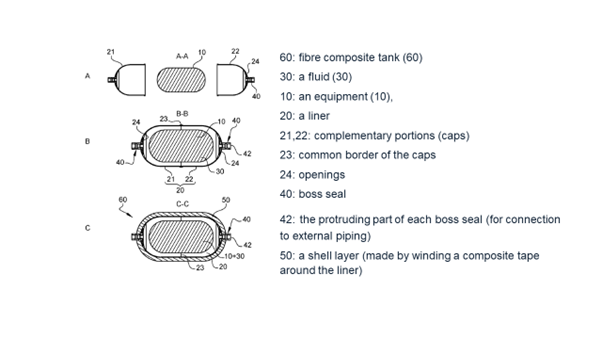Applicants: COVESS and AIR Liquid
Inventors: Philippe PAPIN and Tony VANSWIJGENHOVEN
Patent number: EP4400293A1
Publication date: 2024-07-17
The invention relates to a method of manufacturing a cylindrical fibre composite tank for containing equipment and a fluid, in particular a pressurised fluid. It also relates to a fibre composite cylindrical tank of the type obtained by this method. The invention has applications in the field of gas transport, in particular the transport of pressurised gas.
The problem
Cylindrical fibre composite tanks or vessels are known and often produced by winding continuous filaments impregnated with a thermosetting resin over an inner bottle (also known as a "liner") which remains in the tank after the filament winding step. The liner is sufficiently rigid to be tightly wrapped with continuous fibres to act as a gas and/or liquid barrier. However, the disadvantage of such a method is that the cylinder is heavy and expensive.
Another known method, disclosed in patent document US 4760949, proposes the formation of a composite container for the storage of products in non-atmospheric conditions. The composite container includes a liner member having a metal layer, no part of which is exposed to the interior of the composite container in which the liner is used. The disadvantage of this method is that the container cannot withstand high pressures (e.g. 2 bar or more).
Another method, disclosed in patent document WO 2011/143723, proposes a type V thermoplastic container capable of withstanding a pressure higher than 2 bar and having a barrier effect similar to that of the bottle, but without using a bottle. Such a tank comprises an inner barrier layer comprising a heat-sealable thermoplastic material, an outer shell layer comprising a fibre-reinforced heat-sealable thermoplastic material, an end fitting positioned on the inside of the inner barrier layer and at least partially covered on its outer concave surface with a heat-sealable thermoplastic material. The inner barrier layer, the outer skirt layer and the end fitting form a unitary rigid structure capable of withstanding an overpressure of at least 2 bar.
In some applications, the presence inside the tank or container of equipment is required in addition to the fluid (gas or liquid). For example, in an electrolysis application, electrodes or other electrical material must be placed in the fluid inside the tank. In several aerospace applications, a membrane needs to be placed inside the tank to separate two gases such as nitrogen and oxygen.
Until now, only containers or tanks with a metal inner cylinder have allowed such applications.
The solution
Therefore, Covess and Air Liquide developed a fibre composite tank that can both house the equipment and withstand an overpressure of 2 bar or more.
The invention relates to a method for manufacturing a fibre composite comprising the following steps:
- assembling complementary parts of a liner around the equipment and/or maintaining a support holding the equipment
- sealing the complementary portions together to form the liner with the equipment stable inside the liner; and
- introducing the fluid into the liner through apertures formed in the conduit; and a step of forming an envelope layer by winding a composite tape around the liner, the composite tape being made of a thermosetting or thermoplastic composite material.
In addition, the invention relates to a fibre composite tank for containing a fluid and an apparatus made by the method above, forming a unitary rigid structure capable of withstanding an overpressure of at least 2 bar.
Sectional view of the composite fibre tank according to an embodiment of the invention, at three different steps in the manufacture of said tank:
A: assembling complementary parts of a liner around the equipment and/or maintaining a support holding said equipment
B: sealing the complementary parts together
C: introducing the fluid into the liner through apertures formed in the liner and forming an envelope layer by winding a composite tape around the liner.
Advantages
The process offers advantages over the current state of the art by enabling the creation of fibre composite tanks that can house equipment alongside fluids under high pressure. The design allows for a lightweight yet strong tank construction, overcoming the disadvantages of heavy and expensive conventional methods.







